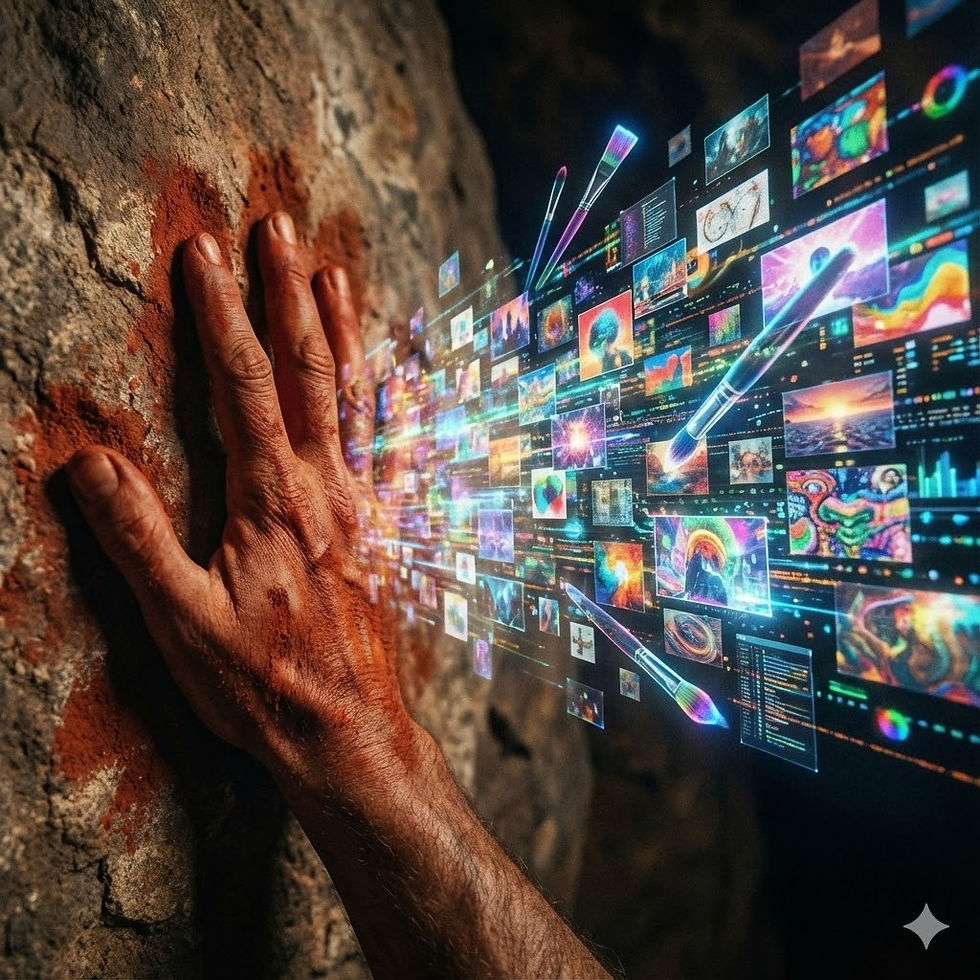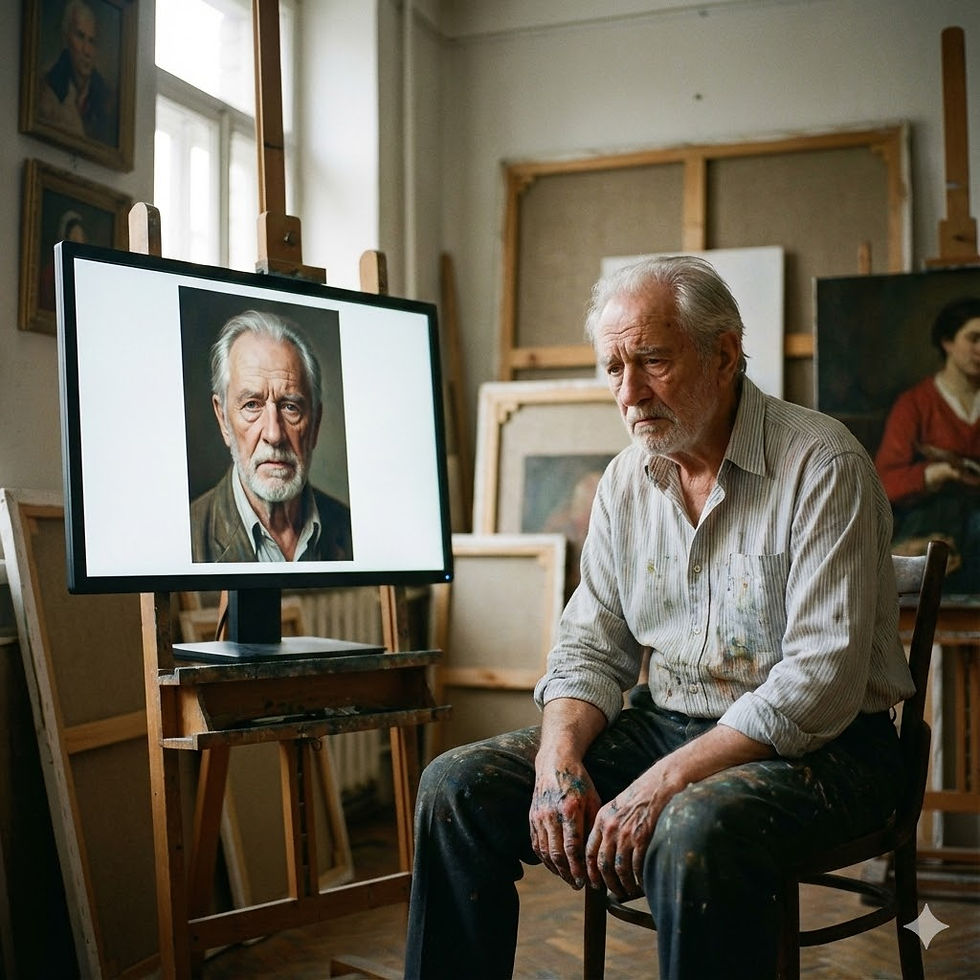Artistic Avenues Square Up: Digital Art (NFTs) vs. Traditional Canvas
- Phoenix

- Jun 14
- 7 min read
Updated: Nov 30

👑🎨 The Battle for the Soul of the Art World
For centuries, the art world has been defined by the tangible: the textured stroke of oil on canvas, the cold permanence of marble, the unique physical object. This was the undisputed kingdom of traditional art. But a digital revolution, supercharged by blockchain technology and Non-Fungible Tokens (NFTs), has stormed the gates, challenging the very definition of what it means to create, collect, and own art.
This is more than a battle of aesthetics; it's a profound clash of philosophies. On one side, the established world of physical galleries, auction houses, and the singular, touchable masterpiece. On the other, a decentralized, digital-native movement championing verifiable ownership of intangible assets. Where is the art world's soul to be found?
Quick Navigation:
I. 💰 Value & Investment: Where Is the Smart Money?
II. 🏛️ Permanence & Legacy: What Will Last for 500 Years?
III. 🔐 Authenticity & Ownership: What Does It Truly Mean to "Own" Art?
IV. 🌐 Accessibility & Community: Who Gets to Participate?
V. 🌍 The Royal Decree & The "Creative Compass" Protocol
Let's step into the gallery and examine this masterpiece of a conflict. 🚀
The Core Content: An Artistic Inquisition
Here is your comprehensive analysis, categorized by the core questions that define value in the art world.
I. 💰 Value & Investment: Where Is the Smart Money?
Art has always been an asset class. This is a battle between the established, stable value of the old masters and the volatile, high-risk/high-reward world of digital assets.
🥊 The Contenders: A physical painting by a renowned artist vs. an NFT from a blue-chip digital artist like Beeple or a collection like CryptoPunks.
🏆 The Verdict: Traditional Canvas for stability; Digital Art (NFTs) for high-risk, high-reward speculation.
📜 The Royal Decree (Why): The traditional art market is a multi-billion dollar behemoth built on centuries of history, scarcity, and institutional validation. It is a stable, albeit illiquid, store of value. The NFT market, after its meteoric rise and dramatic correction, remains highly volatile. While life-changing returns are possible, so are catastrophic losses. Serious, conservative capital still resides in the tangible world, while venture-minded collectors and tech enthusiasts dominate the digital space.
II. 🏛️ Permanence & Legacy: What Will Last for 500 Years?
A key component of art's value is its ability to endure, to carry a message across generations. This is a fight between physical decay and digital obsolescence.
🥊 The Contenders: The physical vulnerability of a canvas (to fire, flood, and time) vs. the digital vulnerability of a file (to server failure, file corruption, and format decay).
🏆 The Verdict: A deeply philosophical draw.
📜 The Royal Decree (Why): Traditional art has a proven, albeit fragile, track record. We have paintings that have survived for centuries thanks to meticulous conservation. Digital art's legacy is more complex. The NFT token itself may live forever on the blockchain, but the artwork it points to—often a JPG or MP4 file stored on a server—is far from permanent. While decentralized storage solutions like IPFS aim to solve this, the risk of "link rot" is real. We don't yet know if a JPG will be viewable in 500 years, making the long-term legacy of digital art a massive, open question.
III. 🔐 Authenticity & Ownership: What Does It Truly Mean to "Own" Art?
How can you be certain that a piece of art is genuine and that you are its rightful owner? This is a battle between paper trails and cryptographic proof.
🥊 The Contenders: A certificate of authenticity and a documented history (provenance) vs. a token on an immutable blockchain ledger.
🏆 The Verdict: Digital Art (NFTs), for verifiable ownership.
📜 The Royal Decree (Why): The traditional art world is notoriously plagued by forgeries and disputes over provenance. Authenticating a piece can require years of expert analysis. The blockchain, by contrast, offers a transparent, publicly verifiable, and immutable record of ownership. You can trace the entire history of an NFT from its creation by the artist through every single sale. While the art file itself can be copied, the token of ownership cannot be forged. For proving who owns what, the technology of NFTs represents a revolutionary leap forward in transparency.
IV. 🌐 Accessibility & Community: Who Gets to Participate?
For centuries, the high art world was an exclusive, walled garden. This is a battle between the traditional gallery system and the open, global digital marketplace.
🥊 The Contenders: The exclusive, often intimidating, world of galleries and auction houses vs. online NFT marketplaces like OpenSea and Foundation.
🏆 The Verdict: Digital Art (NFTs), decisively.
📜 The Royal Decree (Why): NFTs have radically democratized the art world. An artist in Münster, Germany can now sell their work directly to a collector in Tokyo without needing gallery representation. Collectors can discover emerging global talent with just a few clicks. Online communities on platforms like Discord and X (formerly Twitter) have formed vibrant, global ecosystems around artists and projects, creating a sense of shared ownership and belonging that the traditional art world often lacks. This direct artist-to-collector connection is arguably the most significant and positive disruption brought by the NFT movement.
V. 🌍 The Royal Decree & The "Creative Compass" Protocol
This is not a battle with a single winner. The canvas is not dead, and the blockchain is not a fad. The future is a gallery where the physical and digital coexist and enrich one another.
The crown is awarded to a new, emerging synthesis: The "Phygital" Art World.
We are seeing traditional artists embedding NFTs into their physical work to prove authenticity. We are seeing digital artists creating stunning physical prints of their work. Museums are building virtual galleries. The true victory isn't one medium vanquishing the other, but the expansion of the very definition of art.
This new world requires a more conscious approach from all participants.

🌱 The "Creative Compass": A Script for Artists & Collectors
In line with our mission, we propose a protocol for engaging with the new art world ethically and with purpose.
🛡️ The Mandate of Authenticity: For artists, your work is your voice. Whether physical or digital, create with intent and integrity. For collectors, support artists who are pushing boundaries and creating genuinely meaningful work, not just speculative assets.
💖 The Command of Connection: Art is a story. Artists, share the story behind your work. Collectors, take the time to learn about the artist, not just the asset. Use art as a starting point for human connection.
🧠 The Due Diligence Edict: The digital world is rife with scams and misinformation. Before collecting an NFT, verify the artist's identity, understand where the art file is stored, and research the project's long-term vision. In the traditional world, always demand and verify provenance. Be an informed participant.
⚖️ The Value Spectrum Principle: Recognize that value is not just financial. Collect pieces that you are passionate about and would be happy to own even if their monetary value went to zero. The greatest return on investment is the daily joy a piece of art brings you.
🤝 The Community Contribution: The art world thrives on participation. Share artists you admire. Engage in thoughtful critique and discussion. Mentor emerging artists. Use your presence to build a more supportive, less transactional creative ecosystem.
By adopting this compass, you become more than a creator or a collector; you become a steward of culture in an exciting new era.
💬 Your Turn: Join the Discussion!
The definition of art is a conversation, and we want you to be a part of it.
Do you believe an NFT, a token pointing to a digital file, can ever have the same emotional weight as a physical painting? Why or why not?
What is your favorite piece of art, and is it physical or digital?
As a creator or collector, what is the single biggest challenge you face in today's art world?
Will museums and traditional galleries successfully adapt to the digital art movement, or will they become relics?
What role should environmental concerns (e.g., the energy consumption of blockchains) play in how we value digital art?
Share your thoughts and perspectives in the comments below! 👇
📖 Glossary of Key Terms:
NFT (Non-Fungible Token): A unique cryptographic token on a blockchain that represents ownership of a specific asset, such as a piece of digital art. It cannot be replicated or interchanged like a currency.
Blockchain: A decentralized, distributed, and immutable digital ledger that records transactions. It is the underlying technology for cryptocurrencies and NFTs.
Provenance: The documented history of a piece of art, including its creation, past owners, and exhibition history. It is a critical part of authenticating and valuing traditional art.
Minting: The process of creating a new NFT by publishing the token on a blockchain.
Smart Contract: A self-executing contract with the terms of the agreement directly written into code. In NFTs, smart contracts manage ownership and can even automate royalty payments to artists on secondary sales.
Phygital: A term describing the blending of the physical and digital worlds, for example, a physical sculpture that is sold with an accompanying NFT to certify its authenticity.
📝 Terms & Conditions
ℹ️ For Informational Purposes Only: This post is for general informational and analytical purposes. It is not financial or investment advice.
🔍 Due Diligence Required: The art and NFT markets are highly volatile and subject to risk. Always conduct your own thorough research before making any purchasing or investment decisions.
🚫 No Endorsement: This analysis does not constitute an official endorsement of any specific artist, platform, or artwork by aiwa-ai.com.
🔗 External Links: This post may contain links to external sites. aiwa-ai.com is not responsible for the content or policies of these third-party sites.
🧑⚖️ User Responsibility: The "Creative Compass" is a guiding framework. Users are solely responsible for their own actions and investments in the art market.

Posts on the topic 🎨 AI in Arts and Creativity:
The AI Artist: A Threat to the "Inner Compass" or Its Best Tool?
Artistic Avenues Square Up: Digital Art (NFTs) vs. Traditional Canvas
Creative AI: 100 Tips & Tricks for Arts & Innovation
Arts & Creativity: 100 AI-Powered Business and Startup Ideas
Arts and Creativity: AI Innovators "TOP-100"
Arts and Creativity: Records and Anti-records
Arts and Creativity: The Best Resources from AI
Statistics in Arts and Creativity from AI
The Role of AI in Preserving and Presenting Cultural Heritage
AI in Writing and Literature
AI in Music Composition and Performance
How is AI changing the way we perceive Art?
What does the Future hold for Art in the age of AI?
The Best AI Tools for Photos
The Best Image Generation
New Art Forms Powered by AI: Blurring the Lines of Creativity
The Future of AI in Art: A Canvas of Possibilities
An Exhaustive Examination of the Problems of AI in Art
AI's Creative Canvas: Exploring the Diverse Applications of AI in Art
Possibilities of AI in Art
Visual Art and AI: A New Era of Creativity
Art and AI: Symbiosis Creating New Horizons




Comments